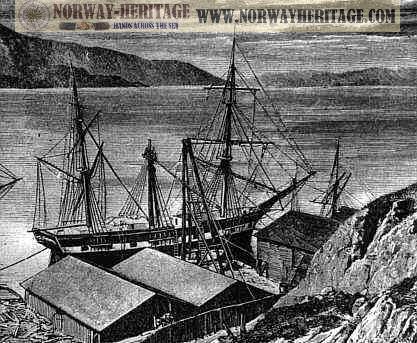
Drammen
to Quebec - and on to Minnesota
The
Kanten Family Immigrates

The Norden docked at Drammen - photo from www.norwayheritage.com
Iver and Anne, together with their 7 sons, made their way to Drammen Norway in 1864 and boarded the immigrant ship, Norden. On June 30, 1864, 10 month old Iver died due to an accident aboard ship.
|
![]()
|
Making the Journey To America There are no contemporary accounts of the Kanten's journey to Minnesota, but an account put on paper by Iver & Anne's great-great-great-grandson, Tyler Kanten from family recollections and oral tradition - gives us some idea of what an ordeal it was. |
|||||
|
|
|
Norden
Crewman Ole Thoreson's Story |
|
Torgrim
Morken's Story The people were bad about stealing from each other; we always had to watch our ale and brandy well...
From Quebec we were sent on by railroad and stuffed into freight cars like animals. However, we thought it was fine because we had never seen a train before and thought it traveled at a great speed. We suffered most from the lack of water. When we stopped anywhere we jumped off to find water and to perform other "errands" and it was very unpleasant. The worst was that people had locked the pumps so we couldn't get water. There were no steps to get down from the [railroad cars] on....
When we came to Sarnia (Ontario) we went over on a ferry to Port Huron, Michigan. Here for the first time I set foot on American ground. Here we were loaded on a steamboat, 400 of us. This was the worst of the whole trip. We could not sit and there was only one toilet for the whole group, so many had to perform their "errands" between crates and barrels and wherever they could. We stopped at every town along Lake Michigan and finally reached Milwaukee.
From here we went westward on our own and were in Minnesota two weeks after we left Quebec."
|
|
|
A Journey to America from Drammen by Clara Jacobsen from the archives of the |
|
|
Copyright Copyright 1998-2022 Hans O. Alm Family All Rights Reserved |